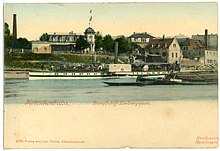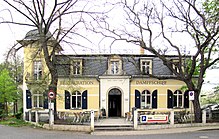Restoration "To the steamship"
The restoration "Zum Dampfschiff" , also known as steamboat restoration , is located at Uferstrasse 10 in the Kötzschenbroda district of the Saxon city of Radebeul . It was built in 1864 as a waiting hall with ancillary buildings directly at the landing stage of the Saxon-Bohemian Steamship Company , which opened in 1837 . Extensive renovations in 1891/1892 gave the restaurant , which is now a listed building , its current cubature.
description
The two-wing building consists of a two-story corner tower with a four-sided hood directly on the street corner, to which the two single -story wings with a platform roof connect to the north and west at right angles. The overall view is five to six window axes.
The tower has two balconies on the upper floor . The wings show in the middle a risalite with a round-arched entrance, above each there is a gable dormer with volutes . In front of the west wing there is an open wooden veranda facing the Elbe. The plastered building is sparingly structured, the arched ground floor windows are framed by folding shutters.
history



The Elbdampfschiffahrts-Gesellschaft , founded in 1836, opened regular steamboat services between the two Elbe cities of Dresden and Meißen on July 30, 1837 . The only stop on the way was the Kötzschenbrodaer pier ( 51 ° 06 ′ 11.7 ″ N , 013 ° 37 ′ 18.3 ″ E ) on October 3, 1837 . The first passenger steamship to stop there regularly was the Queen Maria .
In March 1864, the brickyard owner Friedrich Wilhelm Weinert applied for the construction of a “ waiting hall and side building for the Saxons on his own lot. Dampfschiffahrtsgesellschaft ”, which was renamed the Saxon-Bohemian Steamship Company in 1867 . So by 1865 a simple, rectangular restaurant building with a restaurant, kitchen and utility rooms as well as a bowling alley was built above the steep bank according to plans by the local master mason Moritz Große . This had a size of five to two window axes with knee sticks and a flat gable roof . In the inn or the “popular guest garden”, travelers could wait for their steamer without being forced to eat . Tickets for the steamboat trip were also sold on site. For example, “fresh fish from the Elbe [...] [as] fresh fried fish with potato salad of known quality” were offered for consumption .
On the occasion of a damaged roof, the building was converted in 1891/1892 "in the style of the Wilhelminian era " with a simultaneous, massive expansion of the existing areas. A corner tower was built on the Elbe side of the gable-facing building, also by Moritz Große, to which another wing of the same size was added to the west eaves facing the Elbe. By enlarging the usable area, the steamboat restaurant received a spacious “social room”, space for billiard tables and a salon on the upper floor . This was followed by the construction of an open veranda facing the Elbe and the enlargement of the bowling alley building. Passengers could continue to wait for their connection without consumption.
In 1920 the local rowing club Lößnitz asked for permission to convert the bowling alley into a boathouse.
The restaurant closed in 1958 and the building was used as a residential building from then on. The badly dilapidated but listed building was acquired by the city of Radebeul in 1997 and sold to a private investor in 2001. After extensive renovation measures, a fish restaurant opened there in the same year, which in 2003 created a 60 m long guest terrace directly on the steep bank above the pier .
The fish restaurant located directly on the Elbe Cycle Path had to close in 2004; two years later the inn was reopened with a new concept.
Even today, the pier is approached according to plan by the Saxon Steamship Service .
literature
- Frank Andert (Red.): Radebeul City Lexicon . Historical manual for the Loessnitz . Published by the Radebeul City Archives. 2nd, slightly changed edition. City archive, Radebeul 2006, ISBN 3-938460-05-9 .
- Volker Helas (arrangement): City of Radebeul . Ed .: State Office for Monument Preservation Saxony, Large District Town Radebeul (= Monument Topography Federal Republic of Germany . Monuments in Saxony ). SAX-Verlag, Beucha 2007, ISBN 978-3-86729-004-3 .
Web links
- Steamship restoration Altkötzschenbroda. Restaurant Dampfschiff GmbH & Co. KG, accessed on May 1, 2009 .
- "Queen Maria" on the move , presumably contemporary lithography ( memento from January 5, 2013 in the web archive archive.today )
Individual evidence
- ^ Large district town of Radebeul (ed.): Directory of the cultural monuments of the town of Radebeul . Radebeul May 24, 2012, p. 35 (Last list of monuments published by the city of Radebeul. The Lower Monument Protection Authority, which has been located in the Meißen district since 2012, has not yet published a list of monuments for Radebeul.).
- ↑ a b Historical Calendar. (No longer available online.) In: Sächsische Dampfschiffahrt. Sächsische Dampfschiffahrts GmbH & Co. Conti Elbschiffahrts KG, archived from the original on February 26, 2012 ; Retrieved January 20, 2012 . Info: The archive link was inserted automatically and has not yet been checked. Please check the original and archive link according to the instructions and then remove this notice.
- ↑ Gottfried Thiele : All about the Sparkasse zu Kötzschenbroda . History of a 110-year-old savings bank and stories of a centuries-old place. Ed .: Kreissparkasse Meißen. Radebeul 1997, p. 10/11 .
- ↑ Volker Helas (arrangement): City of Radebeul . Ed .: State Office for Monument Preservation Saxony, Large District Town Radebeul (= Monument Topography Federal Republic of Germany . Monuments in Saxony ). SAX-Verlag, Beucha 2007, ISBN 978-3-86729-004-3 , p. 287 .
- ↑ a b c Frank Andert (Red.): Stadtlexikon Radebeul . Historical manual for the Loessnitz . Published by the Radebeul City Archives. 2nd, slightly changed edition. City archive, Radebeul 2006, ISBN 3-938460-05-9 , p. 37 .
Coordinates: 51 ° 6 ′ 13 ″ N , 13 ° 37 ′ 17.7 ″ E


